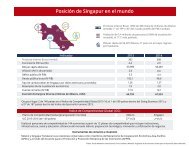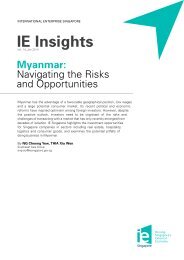basic-guide-to-exporting_Latest_eg_main_086196
basic-guide-to-exporting_Latest_eg_main_086196
basic-guide-to-exporting_Latest_eg_main_086196
You also want an ePaper? Increase the reach of your titles
YUMPU automatically turns print PDFs into web optimized ePapers that Google loves.
In general, national treatment under the terms of the Paris Convention means that asigna<strong>to</strong>ry country will not discriminate against nationals of another signa<strong>to</strong>ry countryin granting patent or trademark protection. Therights provided by a foreign country may b<strong>eg</strong>reater or less than those provided under U.S. law,but the rights provided will be the same as thosethat the country provides <strong>to</strong> its own citizens.The Paris Convention’s right of priority providesan established alternative <strong>to</strong> filing applicationsin many countries simultaneously. It allowsthe applicant 1 year from the date of the firstapplication filed in a Paris Convention country(6 months for a design or trademark) in which <strong>to</strong>file in other countries. This means that after firstFirst signed in 1883 and<strong>to</strong>day enforced by theWorld Intellectual PropertyOrganization, the ParisConvention is <strong>to</strong>day oneof the world’s most widelyadopted treaties.filing, neither publication or sale of an invention, nor use of a mark, will jeopardizepatentability in countries that grant a right of priority <strong>to</strong> U.S. applicants, as long astheir application is submitted before the end of the priority period.Not all countries adhere <strong>to</strong> the Paris Convention, but similar benefits may be availableunder another treaty or bilateral agreement. These substantive obligations have beenincorporated in<strong>to</strong> the World Trade Organization (WTO) Agreement on Trade-RelatedAspects of Intellectual Property Rights (TRIPs) and are binding on WTO members.The United States is also a party <strong>to</strong> the PatentCooperation Treaty (PCT), which providesprocedures for filing patent applications in itsmember countries. The PCT allows you <strong>to</strong> fileone international application that designatesmember countries in which a patent is sought.Filing the international application extends by18 months the period in which you may fulfillthe national requirements for each country.The Paris Convention helpswith patent and trademarkprotection because signa<strong>to</strong>rycountries are not allowed <strong>to</strong>discriminate against eachothers’ companies.International Copyright LawThe United States abides by international copyright r<strong>eg</strong>ulations, which are governedprincipally by the Bern Convention for the Protection of Literary and Artistic Works,<strong>to</strong> which about 160 other nations adhere. The United States is also a member ofthe Universal Copyright Convention (UCC) and has special bilateral relations with anumber of foreign countries. Under the Bern Convention, works created by a nationalof a Bern Union country, or works first or simultaneously published in a Bern country,are au<strong>to</strong>matically eligible for protection in every other country of the Bern Union,without r<strong>eg</strong>istration or compliance with any other formality of law.These rules apply <strong>to</strong> works first published in the United States on or after March 1,1989. Works first published before March 1989 were protected in many countries112U.S. Commercial Service • A Basic Guide <strong>to</strong> Exporting





